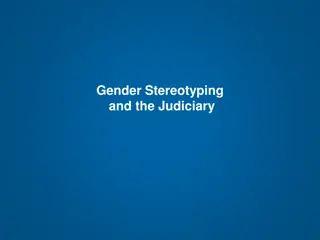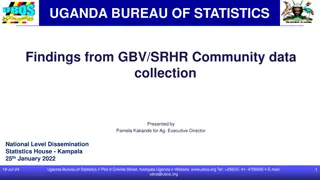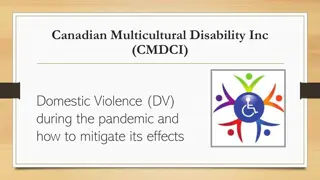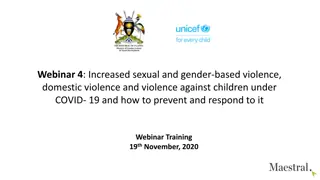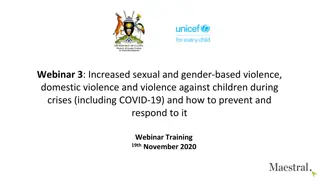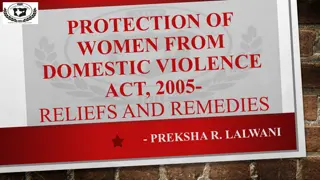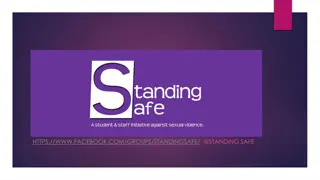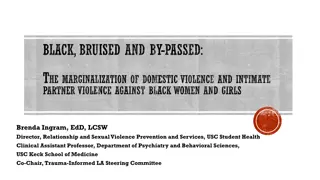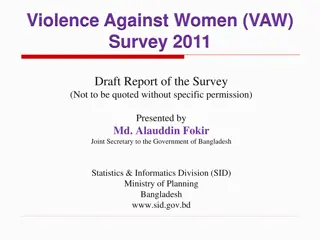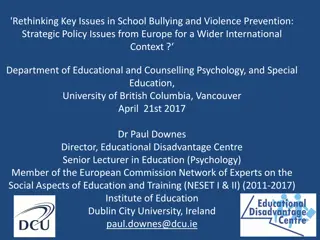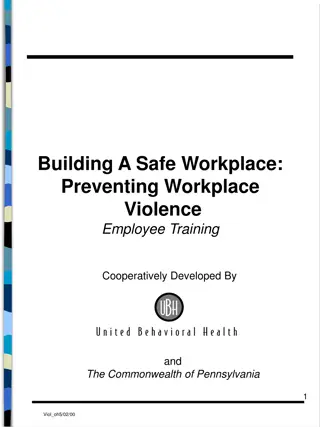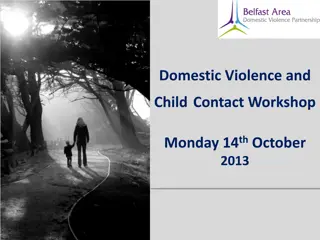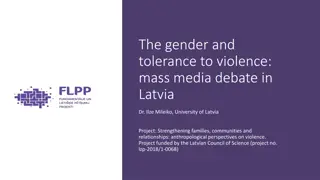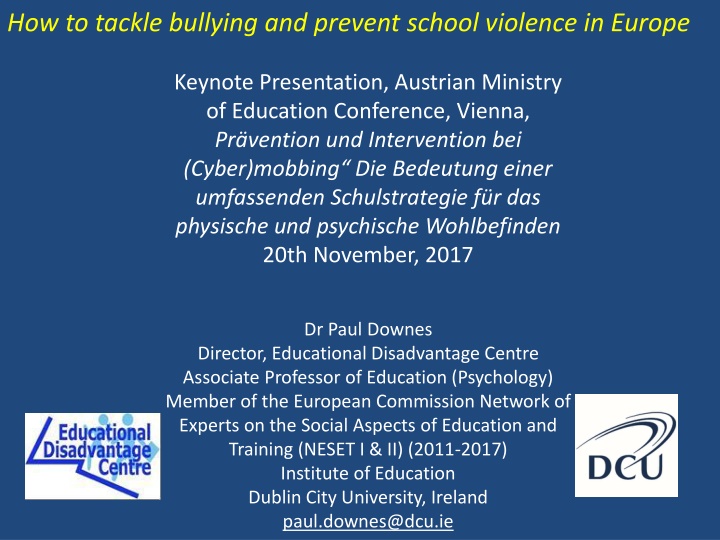
Tackling Bullying and School Violence in Europe Conference Keynote
Explore evidence-based strategies for preventing bullying and school violence in Europe, as presented by Dr. Paul Downes at the Austrian Ministry of Education Conference. Learn about inclusive school practices, cross-government cooperation, and the importance of social and emotional education in creating safe and welcoming school environments.
Download Presentation

Please find below an Image/Link to download the presentation.
The content on the website is provided AS IS for your information and personal use only. It may not be sold, licensed, or shared on other websites without obtaining consent from the author. If you encounter any issues during the download, it is possible that the publisher has removed the file from their server.
You are allowed to download the files provided on this website for personal or commercial use, subject to the condition that they are used lawfully. All files are the property of their respective owners.
The content on the website is provided AS IS for your information and personal use only. It may not be sold, licensed, or shared on other websites without obtaining consent from the author.
E N D
Presentation Transcript
How to tackle bullying and prevent school violence in Europe Keynote Presentation, Austrian Ministry of Education Conference, Vienna, Pr vention und Intervention bei (Cyber)mobbing Die Bedeutung einer umfassenden Schulstrategie f r das physische und psychische Wohlbefinden 20th November, 2017 Dr Paul Downes Director, Educational Disadvantage Centre Associate Professor of Education (Psychology) Member of the European Commission Network of Experts on the Social Aspects of Education and Training (NESET I & II) (2011-2017) Institute of Education Dublin City University, Ireland paul.downes@dcu.ie
Downes, P. & Cefai, C. (2016). How to tackle bullying and prevent school violence in Europe: Evidence and practices for strategies for inclusive and safe schools. Luxembourg: Publications Office of the European Union. https://bookshop.europa.eu/en/how-to-prevent-and-tackle-bullying- and-school-violence-pbNC0415454/ Aim/Scope of Report: To inform policy-makers and practitioners at EU, national, regional and local level on strategies and practices for prevention of bullying and violence in schools across the EU. Combines European legal and policy focus with international empirical research A particular focus on bullying and violence with regard to age, ethnicity and migrants, disability, social inclusion, sexual orientations and gender.
* Examines evidence from European and international research on bullying in schools, aggression and violence, developmental psychology, and school health promotion. *Informed also by responses on current national strategies in Europe from Members of the ET 2020 School Policy Working Group coordinated by the European Commission, Directorate-General for Education and Culture, international researchers from ENSEC (European Network for Social and Emotional Competence) and a number of NGOs across EU Member States. Supplemented by : Downes, P., Nairz-Wirth, E., Rusinaite, V. (2017). Structural Indicators for Developing Inclusive Systems in and around Schools in Europe. Luxembourg: Publications Office of the European Union. https://bookshop.europa.eu/en/structural-indicators-for-inclusive- systems-in-and-around-schools-pbNC0116894/
A. Overview of Problems 1. Serious Consequences of Bullying 2. Cross-Government Cooperation between Education, Health and Social Affairs in Austria ? 3. Internationally Above Average Prevalence of Being Bullied in Austria 4. Bullying: A Hidden Problem 5. Preventing the Consequences of Bullying 6. Beyond Authoritarian Teaching and Discriminatory Bullying Homophobic Bullying Not Directly Addressed in Austrian National Anti-Bullying Strategy 7. Holistic Systemic Issues: School Belonging and Feeling Like an Outsider
B. Strategic Issues for Solutions 8. A Holistic Curricular Focus on Social and Emotional Education (SEE) for Bullying Prevention: Emotional Awareness and Students Voices 9. Differentiated Needs: All, Some, Few Individual 10. Indicated Prevention: Speech and Language Therapists as Part of Multidisciplinary Teams 11. Family Support Services for High Risk Chronic Need 12. Older Students Voices and Co-Construction of Resources for School Bullying and Violence Prevention 13. Questioning A Peer Defenders Approach in KiVa, Finland 14. Common system supports needed for bullying and early school leaving prevention
Serious Consequences of Bullying There is a growing recognition of the serious impact of school bullying on mental health, physical health and early school leaving Victims are likely to experience low self-esteem, anxiety, depression, and suicidal ideation (Gladstone et al., 2006; Klomeck et al., 2009; Nansel et al., 2001; Radliff et al., 2015; Juvonen and Graham, 2014; Ttofi et al., 2011; Swearer et al., 2012; Biereld, 2014).
Victimisation (i.e. being bullied) has also been linked to lower academic achievement and other behaviours such as disengagement, absenteeism and early school leaving (Fried and Fried, 1996; Glew et al., 2005; Nakamoto and Schwartz, 2010; Brown et al., 2011; Green et al., 2010). Victims are more likely to experience worse concentration in class (Boulton et al., 2008) and more interpersonal difficulties (Kumpulainen et al., 1998).
Beran (2008) concluded that preadolescents who are bullied are at some risk for demonstrating poor achievement, although this risk increases substantially if the child also receives little support from parents and is already disengaged from school. The Longitudinal Survey of Young People in England (Green et al., 2010) age 16 young people who reported being bullied at any point between ages 14-16 are disproportionately likely to not be in education, employment or training.
A study of over 26,000 Finnish adolescents found that involvement in bullying was associated with a range of mental health problems such as anxiety, depression and psychosomatic symptoms (Kaltiala-Heino et al., 2000) Frequent victimisation at age 8 predicted later suicide attempts and completed suicides for both boys and girls, while frequent bullying perpetration at age 8 also predicted later suicide attempts and completed suicides for boys (Klomek et al., 2009).
Ttofi et al. (2011) reported that the probability of depression up to 36 years later was much larger for victimised students when compared to non-bullied peers, even after controlling for other factors. Large-scale study with 14 500 participants in the UK, Bowles et al. (2015) - peer victimisation in adolescence is a significant predictor of depression in early adulthood; about 1 in 3 cases of depression among young adults may be linked to peer victimisation in adolescence.
The worst off group however, appears to be the bully-victims, who experience higher levels of both internalised (depression, anxiety, psychosomatic symptoms) and externalised (behaviour problems, delinquency) difficulties than either the victims or the bullying perpetrators (Nansel et al., 2004; Ivarsson et al., 2005; Kokkinos and Panayiotou, 2004; Houbre et al., 2006; Swearer et al., 2012). Bully-victims are also more likely to come from dysfunctional families or have pre-existing conduct, behaviour or emotional problems and it has been suggested that these factors, rather than bullying per se, may explain adult outcomes (Sourander, Ronning et al., 2009).
The Finnish population based, longitudinal birth cohort study of 2551 boys from age 8 years to 16 20 years (Sourander et al., 2007) found that frequent bullies display high levels of psychiatric symptoms in childhood. In their systematic review of 28 longitudinal studies, Ttofi et al. (2011b) and Farrington et al. (2012) reported that bullying perpetrators are likely to offend and to engage in violent behaviour six years later
Bullying perpetrators and bully/victims had the lowest connection to school and poorest relations with teachers (Raskauskas et al., 2010). Bullying prevention is a child welfare and child protection issue (Downes & Cefai 2016).
Cross Government Cooperation on ELET (Early Leaving from Education and Training): Policy Areas Working with Education at Central/Top-Level, 2013/2014 Extracted from European Commission/EACEA/Eurydice/ CEDEFOP (2014, p.68), in Downes & Cefai 2016. Austria: Cooperation mechanisms exist/are being developed Education and Social Affairs Austria: No comprehensive strategy/no specific ELET policies/measures - Education and Health Not - There is a tradition of cross-government cooperation at central/top -level Not- Cooperation mechanisms are being tested within projects Cross Government Bullying Cooperation ???
Internationally Above Average Prevalence of Being Bullied in Austria 25% of 13 year old boys are bullied. 32% of 15 year old boys and 28% of 13 year old boys bully their peers (Currie et al. 2012)
Country 11 years 13 years 15 years Range Total F M F M F M F M Range Austria 16 20 16 25 9 19 9- 16 4-7 5-7 4-7 19- 25 9-25 Denmar k German y Greece 7 7 7 7 4 5 11 11 10 9 8 12 8- 11 7-9 8- 9- 12 8-11 7 8 7 9 9 12 7-12 12 Hungary 8 13 8 9 4 5 4-8 5- 4-13 13 TABLE 1. Peer Victimisation in Europe, % (i.e. those reporting being a victim of bullying) WHO 2010
BULLYING: A HIDDEN PROBLEM(Downes 2004) I d have guards to guard me to stop anyone starting on me (4th class, M, FG) I would put cameras on the walls so they would know who is bullying (4th class, M, Q) bullys, blow up the school (5th class, M, Q) I would make all the school a bullyfree zone (6th class, M, Q) I would change all the bullies in my school to geeks (6th class, F, Q) One of the biggest problems in the school is bullying (5th class, M, FG) but you don t wanna be a rat (5th class, M, FG) I would be absent because sometimes I get bullied (5th class, M, Q) No-one will end up in school if they keep getting bullied (6th class, M, FG)
Teachers and Wider Support Services Role in Preventing the Consequences of Bullying (Downes & Cefai 2016): Building on Students Experiences Given the seriousness of the long-term impacts of bullying (Mental Health, Early School Leaving) a prevention strategy needs to encompass not only prevention of the bullying but prevention of the consequences of bullying through system level emotional and social supports Supports could intervene at an early stage to prevent the escalation of experiential processes, such as selfdoubting and double victimising, described in a Swedish context (Thornberg et al., 2013).
Radliff et al. (2015) hopelessness as a mediator for bullying. -469 US middle school students, victims reported the highest levels of hopelessness and significantly higher scores compared with students not involved in bullying. Hopelessness was a mediator for victims, but not for bully- victims. Thornberg s (2015) Swedish ethnographic fieldwork in two public schools (age 10 to 12 years): Resignation and a range of escape or avoidance behaviour, such as social withdrawal and avoiding others, as well as trying to be socially invisible in the classroom and other school settings. Also prevent consequences of aggressive communication for perpetrators through early Intervention (Downes & Cefai 2016)
Beyond Authoritarian Teaching and Discriminatory Bullying Teacher discriminatory bullying of students in a sample of 1352 immigrant and Roma students as part of a wider sample of 8817 students across 10 European countries (Bulgaria, Cyprus, France, Germany, Greece, Italy, Portugal, Romania, Slovenia, Spain) (Elam 2013). Elam s(2013) 10 country European study regarding the fundamental importance of teacher influence on discriminatory bullying -Those immigrant and Roma students who think the teacher exhibits similar behaviour towards native and immigrant and Roma children in the class are those bullied least in the last 3 months. In contrast, those who declare that their teacher favours native children over immigrant/Roma students are more vulnerable to suffer some form of bullying.
Greek study (Kapari and Stavrou, 2010) of 114 secondary school students (58 female, 56 male) drawn from three Greek public middle schools. In schools with high levels of bullying, students consider their treatment by adults to be unequal, the rules to be unfair, and student participation in decision-making to be very limited.
Authoritarian Teaching WHO (2012) Modifications that appear to have merit include: establishing a caring atmosphere that promotes autonomy; providing positive feedback; not publicly humiliating students who perform poorly; Cefai & Cooper (2011), Malta review of qualitative research: the autocratic and rigid behaviour management approach adopted by many teachers in their response to misbehaviour. Their blaming and punitive approach was seen in many cases as leading to an exacerbation of the problem...It looks...that perceived victimisation by teachers was more prevalent and had more impact than victimisation and bullying by peers
Homophobic Bullying Directly Addressed in National Anti- Bullying Strategy (Downes & Cefai 2016) Austria Belgium (Fl) Bulgaria Cyprus Czech Republic England Estonia Finland France Greece Hungary Ireland No No, but some focus in anti- discrimination law No No No No, but in individual schools No No No, not directly but it is on the Ministerial agenda No No Yes
* Homophobic bullying lacks a strategic focus in many EU Member States. According to the EU Agency for Fundamental Rights' survey, the highest levels of hostility and prejudice towards LGBTI groups recorded in the EU are in Bulgaria, Hungary, Italy, Latvia, Lithuania, Poland and Romania. * It is notable that very few of these countries address prevention of homophobic bullying in schools in a strategic manner. * The prevention of discriminatory bullying in school (against groups such as Roma, minorities, migrants, as well as against those experiencing poverty and socio-economic exclusion) needs a stronger strategic focus in many EU Member States.
Holistic Systemic Issues: Percentage of Socioeconomically Disadvantaged Students who Agree/Disagree with the Following Statements: School Belonging and Feeling Like an Outsider (PISA 2012) (OECD 2012) I feel like an outsider (or left out of things at school), % Disagree (S.E) 89.9 (1.1) 88.4 (1.0) 80.5 (1.6) 90.3 (1.0) 90.0 (1.3) 89.2 (1.0) 73.2 (1.8) 89.7 (1.4) 83.9 (1.4) 85.6 (1.6) 91.6 (1.0) 89.3 (0.6) 85.9 (1.2) 89.8 (1.3) 89.1 (1.0) 86.2 (0.2) I feel like I belong at school, % Agree (S.E) Countries Austria Belgium Czech Republic Denmark Estonia Finland France Germany Greece Hungary Ireland Italy Luxembourg Netherlands Norway OECD Average 82 (1.6) 63.5 (1.6) 73.6 (1.9) 69.3 (1.6) 78.2 (1.8) 80.5 (1.1) 38 (1.7) 83.8 (1.6) 87.8 (1.2) 83.5 (1.1) 76.7 (1.5) 75 (0.9) 71.9 (1.7) 82.4 (1.7) 83.5 (1.5) 78.1 (0.3) United Kingdom 74.9 (1.5) 86.9 (1.1)
A Holistic Curricular Focus on Social and Emotional Education (SEE) for Bullying Prevention: Emotional Awareness and Students Voices A study of more than 213 programs found that if a school implements a quality SEL curriculum, they can expect better student behaviour and an 11 point increase in test scores (Durlak et al., 2011). The gains that schools see in achievement come from a variety of factors students feel safer and more connected to school and academic learning, children and teachers build strong relationships. Durlak et al. (2011) highlight a range of SEL benefits indirectly related to bullying and school violence, for outcomes on SEL skills, Attitudes, Positive Social Behaviour, Conduct Problems, Emotional Distress and Academic Performance.
Durlak et al (2011) classroom teachers and other school staff effectively conducted SEL programs so these can be incorporated into routine educational activities and do not require outside personnel. Sklad et al. s (2012) meta-analysis of recent, school-based, universal programs concentrated on ones that promote development rather than prevent specific problems such as bullying. -SEL programs showed statistically significant effects on social skills, antisocial behaviour, substance abuse, positive self-image, academic achievement and prosocial behaviour. Downes (2010) SEL across curricular areas: empathy in history, language and emotion in English, conflict role play in drama etc.
Differentiated Needs Universal All Selected Some, Groups, Moderate Risk Indicated Individual, Intensive, Chronic Need
Indicated Prevention: Speech and Language Therapists as Part of Multidisciplinary Teams The need for speech and language therapists to be linked with schools, as part of multidisciplinary teams to engage in targeted intervention for language development, emerges from international research regarding language impairment as a risk factor for engagement in disruptive behaviour. Eigsti and Cicchetti (2004) found that preschool aged children who had experienced maltreatment prior to age 2 exhibited language delays in vocabulary and language complexity. The mothers of these maltreated children directed fewer utterances to their children and produced a smaller number of overall utterances compared to mothers of non-maltreated children, with a significant association between maternal utterances and child language variables.
Rates of language impairment reach 24 % to 65 % in samples of children identified as exhibiting disruptive behaviours (Benasich et al., 1993), and 59 % to 80 % of preschool- and school-age children identified as exhibiting disruptive behaviours also exhibit language delays (Beitchman et al., 1986; Brinton and Fujiki, 1993; Stevenson et al., 1985). A study of children with communication disorders found that children with language impairments, who were more widely accepted, seemed to be protected from the risk of being bullied (Savage, 2005).
The particular lack of speech and language therapists (SLTs) in European schools as part of multidisciplinary teams, highlighted in the Eurydice report (2014) on early school leaving, is of real concern here for students at the chronic need, indicated prevention level, where maternal language difficulties may be affecting their violent behaviour The level of maternal language difficulty does not have to be at a clinical level of difficulty for it to centrally contribute to a range of school-related problems, potentially including aggression and bullying, as well as hindering social relationships and sense of belonging to school.
A Differentiated Approach to Involving Parents for Bullying Prevention: Family Support Services for High Risk Chronic Need Systematic review by Lereya et al. (2013) involving 70 studies which concluded that both victims and bully/victims are more likely to be exposed to negative parenting behaviour, including abuse and neglect and maladaptive parenting.
Cross et al.s (2012) Australian study - all grade levels from 1 (56- year olds) to 7 (12 13-year olds). The family level activities worked in partnership with parents by building their awareness, attitudes and self-efficacy to role model and help their children to develop social competence and to prevent or respond to bullying. These activities also encouraged school and parent communication and parents engagement with the school to reduce student bullying. The high intensity intervention (wholeschool, capacity building support and active parent involvement) is somewhat more effective than the moderate intensity intervention (whole-school and capacity building support only), and substantially more effective than the low intensity intervention (the standard school program with no capacity support).
Langford et al.s (2014) Cochrane Review for the WHO on health promoting school interventions highlighted that The majority of studies only attempted to engage with families (rather than the community), most commonly by sending out newsletters to parents. Other activities included: family homework assignments, parent information evenings or training workshops, family events, or inviting parents to become members of the school health committee . Downes & Cefai (2016): Again this emphasis is overwhelmingly one where the parent is a passive recipient of information, with the exception of the example of the invitation for them to be members of the school health committee. Downes (2014) Parental involvement is a dimension of children s rights
Limited Quality of Research Older Students Voices and Co- Construction of Resources for School Bullying and Violence Prevention Yeager et al. (2015) raise a concern about the limitations of intervention strategies for older adolescents that rely on adult authority or that imply that they lack basic social or emotional skills. Secondary school students may resist being literally programmed into particular modes of behaviour and thought. A shift in conceptualisation is needed to make these students subjects of policy rather than simply objects of policy and programmes. In a US context, Yeager et al. (2015) question state mandates regarding anti-bullying programmes for high schools though not for middle schools. They recognise the need for new interventions to be developed and shown to be effective for older adolescents.
A notable aspect of their conclusion is that it is not sufficient to age up existing materials that are tested with younger children, e.g. by switching out the examples or the graphic art used in the activities. The UN Convention on the Rights of the Child may be less influential in US school and research contexts, given that it is not ratified by the US, unlike all EU countries. This would invite consultation with young people in the design of materials for anti-bullying, building on Art. 12, with increasing input from older students. Avoiding intervention for older students would be a legal abdication of responsibility.
Classroom Climate and Bullying: Questioning A Peer Defenders Approach in KiVa, Finland (Downes & Cefai 2016) -Empirical evidence of increased bullying for peer interventions in some international contexts, evidence of student fear of the consequences of intervening. -Recognition of bullying as a child welfare and child protection issue renders it problematic that responsibility may be displaced onto other children to provide support and active defending. -Schools have a duty of care to the individual and not simply to the aggregate of children, so that even gains in the aggregate do not justify disproportionate risk to an individual defender from a perpetrator entrenched in bullying behaviour and likely to target defenders that challenge him/her. -primum non nocere (first do no harm)
Common Strategic Approach for School Bullying, Violence Prevention and Early School Leaving Prevention through common system responses for inclusive systems. Quiroga, Janosz and Bissett (2013) 493 high-risk French-speaking adolescents living in Montreal *depression symptoms at the beginning of secondary school are related to higher dropout mainly by being associated with pessimistic views about the likelihood to reach desired school outcomes; student negative self-beliefs are in turn related to lower self-reported academic performance and predict a higher risk of dropping out. Quiroga et al. (2013) interventions that target student mental health and negative self-perceptions are likely to improve dropout prevention .
Common system supports needed for bullying and early school leaving prevention (Downes & Cefai 2016) School Climate, Teasing, Bullying In a sample of 276 high schools, Cornell et al. (2013) found that risk of early school leaving increases if a student experiences an atmosphere of teasing and bullying even if s/he is not personally bullied. Cornell et al. (2013) Notably, the increased dropout count that was associated with Prevalence of Teasing and Bullying was quite similar to the increases that were associated with FRPM [i.e., poverty] and academic failure .
Common system supports needed for bullying and early school leaving prevention (Downes & Cefai 2016) A striking commonality of interests with regard to strategic approaches for bullying prevention in schools and early school leaving prevention: Direct and indirect effects of bullying on early school leaving relevant to perpetrators, victims (school absence, negative interpersonal relations with peers and conflict with teachers, low concentration in school, decreased academic performance, lower school belonging, satisfaction, and pedagogical well-being, with the effects of bullying exacerbated for those already at risk of early school leaving, negative school climate influences).
Common systems of supports (transition focus from primary to post-primary, multiprofessional teams for complex needs, language support needs, family support services and education of parents regarding their approaches to communication and supportive discipline with their children, outreach to families to provide supports, addressing academic difficulties). Common issues requiring an integrated strategic response, including the prevention of displacement effects of a problem from one domain to another, such as in suspension/expulsion which may make a bullying problem become an early school leaving problem. Common causal antecedents (negative school climate, behavioural difficulties, trauma)
Teacher professional development and pre-service preparation focusing on developing teachers relational competences for a promoting a positive school and classroom climate, including a focus on teachers conflict resolution and diversity awareness competences Early warning systems.
Selected and Indicated Prevention Even apart from poverty related depression, emotional distress contributes to early school leaving: LONELINESS: Frostad et al. 2015 intention to drop out Quiroga et al. (2013) 493 high-risk French-speaking adolescents living in Montreal *depression symptoms at the beginning of secondary school are related to higher dropout mainly by being associated with pessimistic views about the likelihood to reach desired school outcomes; student negative self-beliefs are in turn related to lower self-reported academic performance and predict a higher risk of dropping out. Quiroga et al. (2013) interventions that target student mental health and negative self-perceptions are likely to improve dropout prevention .
The downward spiral of mental disorders and educational attainment: a systematic review on early school leaving Pascale Esch, Val ry Bocquet, Charles Pull, Sophie Couffignal, Torsten Lehnert, Marc Graas, Laurence Fond-Harmant and Marc Ansseau. BMC Psychiatry 2014 14:237 When adjusted for socio-demographic factors, mood disorders (e.g. depression) were significantly related to school dropout Among anxiety disorders, after controlling for potentially confounding factors, social phobia was a strong predictor of poor educational outcomes as indicated by early school leavers themselves, were feeling too nervous in class and being anxious to speak in public, both representing symptoms of social phobia
School Climate, Teasing, Bullying Cornell et al. (2013) a climate of teasing and bullying in the school also deserves consideration. Notably, the increased dropout count that was associated with Prevalence of Teasing and Bullying was quite similar to the increases that were associated with FRPM [i.e., poverty] and academic failure . Cornell et al. (2013) note that dropout programs often focus too narrowly on changes in individual students, without considering broader peer and school influences. Supports could intervene at an early stage to prevent the escalation of experiential processes, such as selfdoubting and double victimising, described in a Swedish context (Thornberg et al., 2013), hopelessness in a US context (Radliff et al. 2015) .
National Ministries of Education (Structural Indicators Yes/No) Whether for a right to health approach or a quality in systems approach to address system blockages - Existence of a national school bullying and violence prevention strategy. - Existence of a national coordinating committee to implement this strategy as part of an inclusive systems approach. - Representation of minority groups/NGOs on national coordinating committee for inclusive systems. - Representation of students on national coordinating committee for inclusive systems. - Representation of parents on national coordinating committee for inclusive systems. - Cross-department scope of national coordinating committee for inclusive systems to include health and social services.
- Bullying prevention built into school self- evaluation processes. - Bullying prevention built into school external evaluation processes - Explicit strategy to address bullying together with early school leaving. - Explicit strategy to directly address discriminatory bullying in schools. - Explicit strategy to directly address homophobic bullying in schools
(Downes, Nairz-Wirth & Rusinaite 2017) Promoting Inclusive Systems Inclusive systems in and around schools invites concern with supportive, quality learning environments, on welcoming and caring schools and classrooms, and on preventing discrimination. It addresses the needs of students in a holistic way (their emotional, physical, cognitive and social needs), and recognises their individual talents and voices. It is open to the voices and active participation of parents, and also wider multidisciplinary teams and agencies. Inclusive systems in and around schools particularly focus on the differentiated needs of marginalised and vulnerable groups, including those at risk of early school leaving, bullying and alienation from society.
Beitchman, J., Nair, R., Clegg, M., Ferguson, B., & Patel, P. G. (1986). Prevalence of psychiatric disorder in children with speech and language disorders. Journal of the American Academy of Child Psychiatry, 25, 528 535. Benasich, A., Curtiss, S., & Tallal, P. (1993). Language, learning and behavioural disturbances in childhood: A longitudinal perspective. Journal of the American Academy of Child & Adolescent Psychiatry, 32, 585 594. Beran, T. (2008). Consequences of being bullied at school. In D. Pepler and W. Craig (Eds.) Understanding and addressing bullying: An international perspective (pp. 44 66). Bloomington, IN: Authorhouse Boulton, M. J., Trueman, M. & Murray, L. (2008) Associations between peer victimization, fear of future victimization and disrupted concentration on class work among junior school pupils, British Journal of Educational Psychology, 78, 473 489 Bowles, L., et al., Peer victimisation during adolescence and its impact on depression in early adulthood: prospective cohort study in the United Kingdom , British Medical Journal, Vol. 350, 2015, h2469 doi: 10.1136/bmj.h2469 Brinton, B., & Fujiki,M. (1993). Clinical forum: Language and social skills in the school-age population: Language, social skills and socioemotional behavior. Language, Speech, and Hearing Services in Schools, 24, 194 198. Brown, V., Clery, E., & Ferguson, C. (2011). Estimating the prevalence of young people absent from school due to bullying. National Centre Soc Res 1-61
Cefai, C and Cooper, P. (2011). The introduction of nurture groups in Maltese schools: a method of promoting inclusive education, British Journal of Special Education. Volume 38, Issue 2, pages 65 72, June 2011 Currie, C.; Zanotti, C.; Morgan, A.; Currie, D.; DeLooze, M.; Roberts, C.; Samdal, O.; Smith, O.; Barnekow, V., Social determinants of health and well-being among young people. Health Behaviour in School-aged Children (HBSC) study: International report from the 2009/2010 survey, WHO Regional Office for Europe, Health Policy for Children and Adolescents, No. 6, Copenhagen, 2012. Downes, P. (2004) Present and Future: Psychological Support Services for Ballyfermot. Dublin: URBAN Downes, P. (2010). Prevention of Bullying at a Systemic Level in Schools: Movement from Cognitive and Spatial Narratives of Diametric Opposition to Concentric Relation. In SR. Jimerson, SM. Swearer, and DL. Espelage (Eds.), Handbook of Bullying in Schools: An International Perspective , Section III., Research-Based Prevention and Intervention (pp.517- 533). New York: Routledge. Downes, P. (2014). Towards a Differentiated, Holistic and Systemic Approach to Parental Involvement in Europe for Early School Leaving Prevention. PREVENT, Urbact: Paris. Downes, P. & Cefai, C. (2016). How to tackle bullying and prevent school violence in Europe: Evidence and practices for strategies for inclusive and safe schools. Luxembourg: Publications Office of the European Union. Downes, P., Nairz-Wirth, E., Rusinaite, V. (2017). Structural Indicators for Developing Inclusive Systems in and around Schools in Europe. Luxembourg: Publications Office of the European Union.

